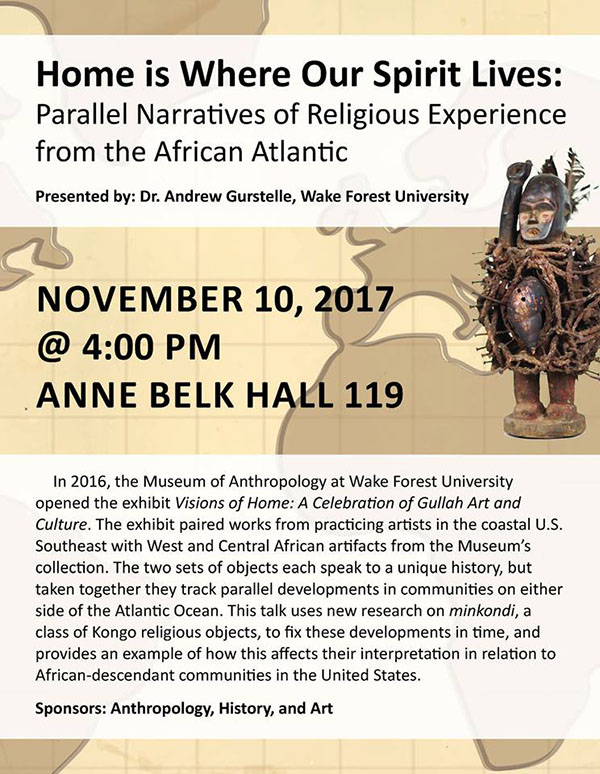Home is Where Our Spirit Lives: Parallel Narratives of Religious Experience from the African Atlantic
Dr. Andrew Gurstelle, Wake Forest University
In 2016, the Museum of Anthropology at Wake Forest University opened the exhibit Visions of Home: A Celebration of Gullah Art and Culture. The exhibit paired works from practicing artists in the coastal U.S. Southeast with West and Central African artifacts from the museum's collection. The two sets of objects speak to a unique history, but taken together they track parallel developments in communities on either side of the the Atlantic Ocean.
This talk uses new research on minkondi, a class of Kongo religious objects, to fix these developments in time, and provides an example of how this affects their interpretation in relation to African-descendant communities in the United States.
Sponsored by the Department of Anthropology, the Department of History and the Department of Art.
About Dr. Andrew Gurstelle
Dr. Andrew Gurstelle (Ph.D., University of Michigan) is a museum anthropologist and archaeologist. Dr. Gurstelle is the Academic Director of Wake Forest University’s Museum of Anthropology. His interest in museums focuses on making them hubs of anthropological research—places where research is both conducted and exhibited. His curatorial work emphasizes putting objects in context, historically and culturally.
Dr. Gurstelle has conducted archaeological and oral-historical research in West Africa, including Ghana, Togo, and Bénin. He is the director of the Savè Hills Archaeological Research Project in Bénin. The project’s goal is to examine the early history and development of the Shabe Yoruba kingdom between 1600 and 1960 CE. Dr. Gurstelle and his colleagues map ancient village sites in relation to geographic features and sacred landforms to demonstrate the social and economic networks that cross-cut West Africa. A second area of research is understanding the practices and material cultures of the pre-Shabe population that has lived in the Savè hills area since at least 1000 CE.
Related to archaeology, Dr. Gurstelle maintains a research interest in the historical arts of West and Central Africa—the sculptures, masks, musical instruments, metal castings, and beadwork exported from Africa in the 19th and 20th centuries. He has conducted research on blue glass trade beads, Yoruba pottery, Kongo power figures, and royal Kuba art.
